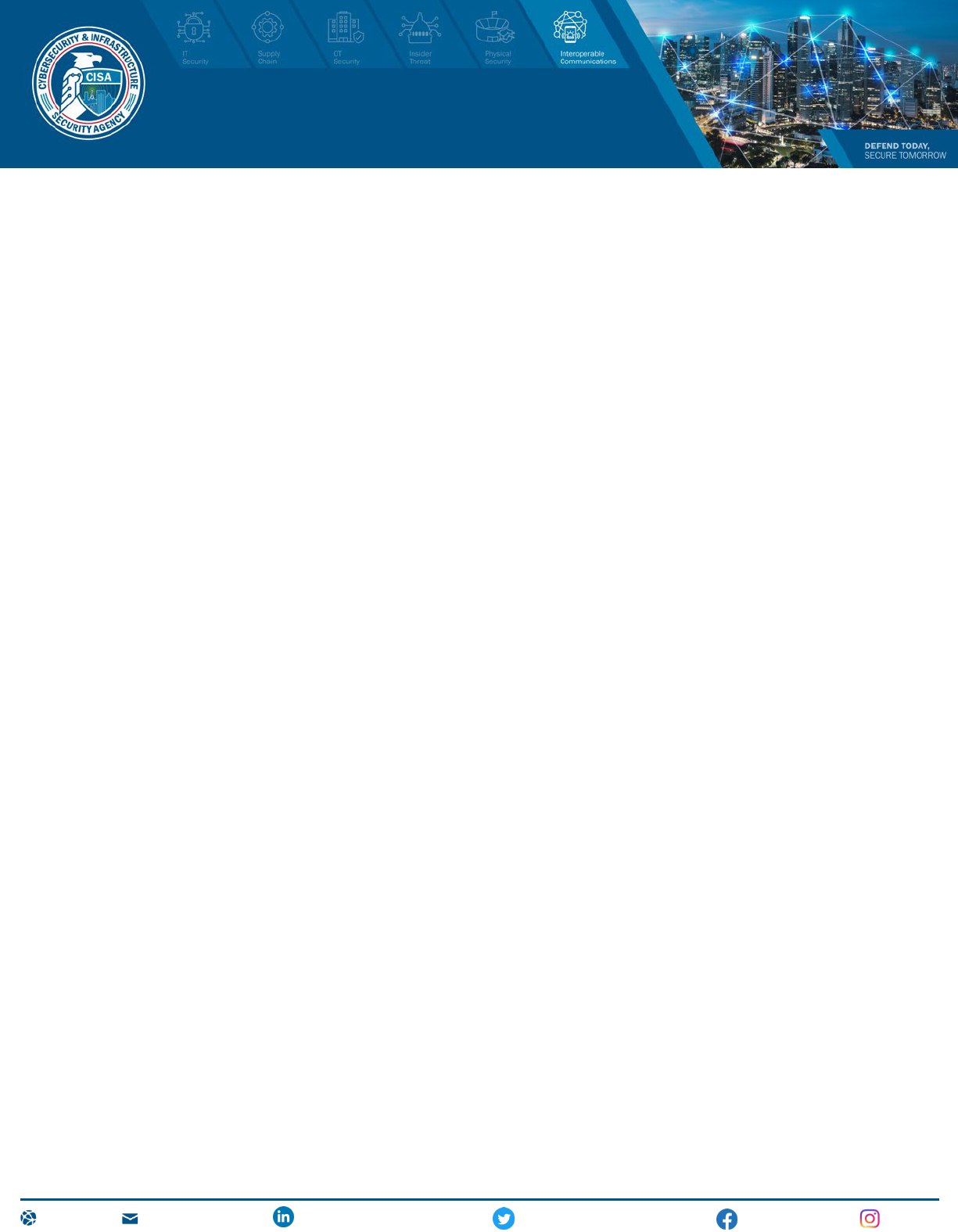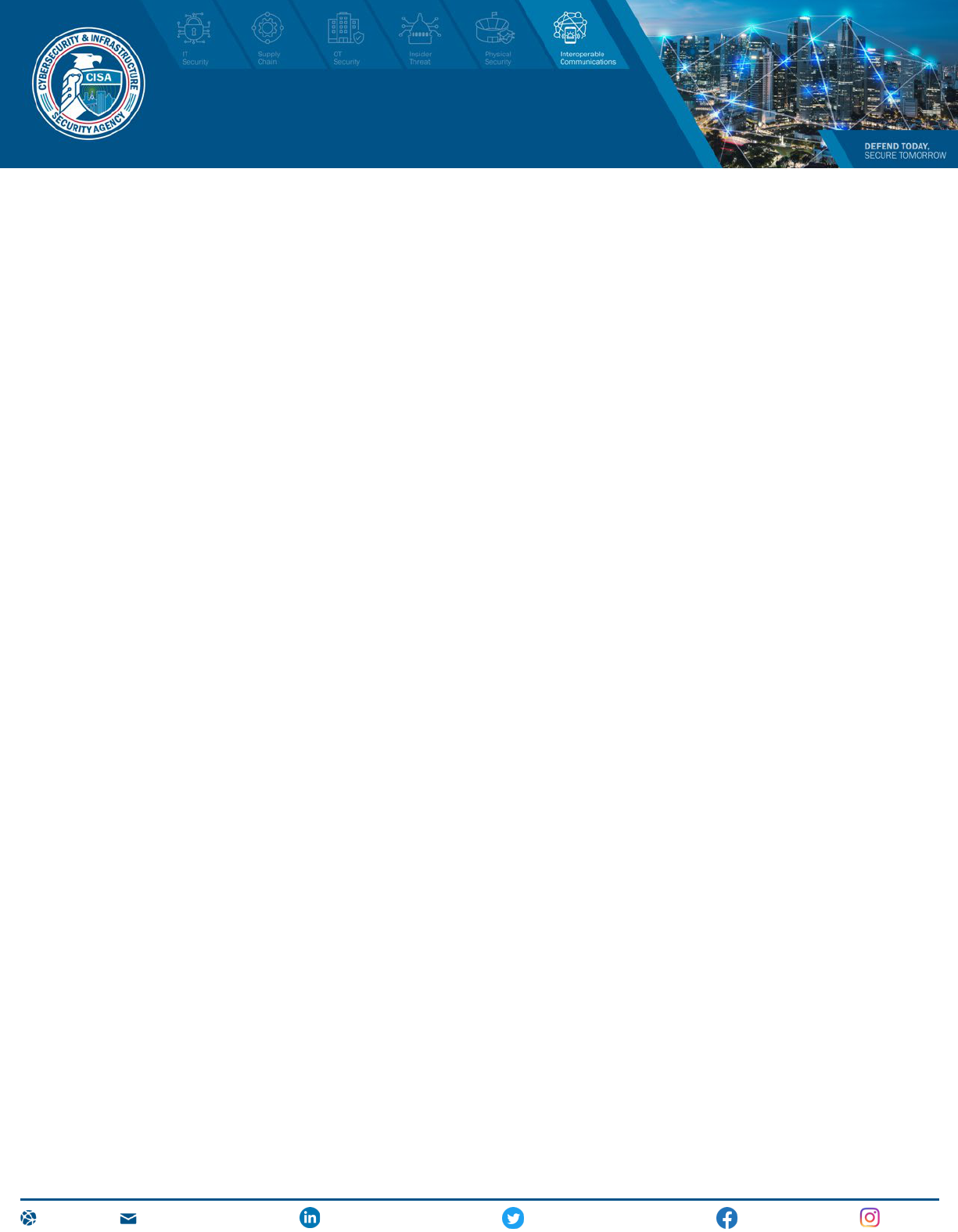
Government Emergency Telecommunications Service
FREQUENTLY ASKED QUESTIONS
WHAT IS THE GOVERNMENT EMERGENCY TELECOMMUNICATIONS SERVICE?
The Cybersecurity and Infrastructure Security Agency’s (CISA) Government Emergency Telecommunications
Service (GETS) provides personnel across all levels of government (federal, state, local, tribal, and territorial
[FSLTT]), the private sector and non-governmental organizations (NGOs) that have essential national
security, national economic security, and national public health or safety missions the ability to complete
landline telephone calls during periods of severe network congestion or disruption. GETS works through a
series of enhancements to the landline network, but also provides priority calling to cell phones on all
nationwide and several regional cellular networks. GETS subscribers receive a GETS card that provides
GETS access phone numbers, a Personal Identification Number (PIN), and dialing instructions.
WHY IS GETS IMPORTANT TO ME?
Obstacles to communication take many forms. Extreme weather (such as hurricanes or earthquakes), cyber-
attacks, terrorist attacks, incidents due to human error or equipment failures, and mass gatherings can
prevent access to the telephone network. GETS facilitates important calls to get through and for vital
information to be shared during these types of scenarios.
WHEN DO I USE GETS?
GETS is used when the landline network is congested and the ability to complete a normal call is hindered.
To build muscle memory, GETS should also be routinely used in exercises or training scenarios.
WHO SHOULD HAVE GETS?
GETS is available to organizations across all levels of government (FSLTT), the private sector, and NGOs that
have essential national security, national economic security, and national public health or safety missions.
These organizations can be found within every one of CISA’s critical infrastructure sectors. The personnel
who perform essential functions across all levels in an organization– from Chief Executive Officers to field
technicians and operators – should have access to GETS.
Organizations that should enroll in priority services:
• Gover
nment organizations and entities at federal, state/district, local (cities/counties), tribal, and
territorial levels
• All agencies and organizations included in emergency management plans
• Any organization within one of the 16 critical infrastructure sectors (whether a governmental or private
sector organization or public/private entity): Chemical, Commercial Facilities, Communications, Critical
Manufacturing, Dams, Defense Industrial Base, Emergency Services, Energy, Financial Services, Food
and Agriculture, Government Facilities [including school districts and higher education organizations],
Healthcare and Public Health, Information Technology, Nuclear Reactors, Materials, and Waste,
Transportation Systems, Water and Wastewater Systems).
• Non-Governmental or academic organizations with security, national economic security, national public
health, or safety missions
Individuals who should be enrolled in GETS/Wireless Priority Service (WPS):
• Executive leadership (the “C-suite” of an organization)
• Media relations
• Emergency management personnel
• Continuity Planning/Continuity of Operations staff
• Department heads/managers and staff essential to continuity of operations
• Subject matter experts/trained specialists
1
cisa.gov/pts
Linkedin.com/company/cisagov
@CISAgov | @cyber | @uscert_gov
Facebook.com/CISA
@cisagov

Government Emergency Telecommunications Service
• Continuity Planning/Continuity of Operations staff
• Front line personnel essential to carrying out organizational mission (all fire/rescue service and law
enforcement personnel, regardless of rank, should be enrolled in GETS/WPS as they are all essential to
their organization’s mission)
HOW MUCH DOES GETS COST?
There is no charge to subscribers to enroll in or use GETS. GETS calls are currently billed to CISA at a rate of
7 to 10 cents per minute (depending on the carrier and other factors) for calls within the United States and
its territories, Canada, and most of the Caribbean. International calls are billed at commercial rates, though
international calling privileges are restricted to specific cards authorized by an organization's point of contact
(POC).
HOW DOES GETS WORK?
GETS is accessed through a universal number (provided to subscribers on a GETS card) using common
telephone equipment (landline, cellular, fax, and satellite phones). A series of prompts direct the entry of the
GETS user’s PIN and destination phone number. Once authenticated, the call receives priority treatment on
the landline and cellular networks.
WHERE CAN I USE GETS?
GETS is available worldwide; however, GETS is primarily intended for calling within the United States and its
territories. You can request international calling privileges for calls to international destinations. However,
GETS provides priority treatment only in the domestic segment of the call. Once a GETS call that originates
overseas reaches the United States it is routed to one of the three GETS interexchange (long distance)
carriers: AT&T, T-Mobile, or Verizon for PIN validation. The call is then routed to its intended domestic or
international destination.
DO I NEED EXTRA HARDWARE OR SOFTWARE?
No. Special phones and/or equipment are not required to use GETS. You will only need the universal GETS
access number and a PIN, located on GETS card.
WILL GETS WORK ON MY CELL PHONE?
You can place a GETS call from a cell phone. However, the call will not receive priority treatment until it
reaches a landline network. GETS calls over cellular networks are most effective when used in conjunction
with WPS-- a companion service to GETS--that offers authorized users priority treatment on the cellular
networks. To receive priority treatment in cellular networks, you must separately subscribe to the WPS.
WHAT FEATURES AND ENHANCEMENTS DOES GETS PROVIDE?
GETS enables call completion even in damaged or congested networks by providing numerous
enhancements and key features:
• Toll-free numbers for direct carrier access
• Access control using PINs
• Failsafe access - if the access control system fails, GETS calls will automatically be allowed to complete
• Enhanced routing to one of the three GETS interexchange (long distance) carriers
• Alternate carrier routing in the event one of the interexchange carriers is unavailable
• Priority treatment with call queuing; GETS calls may queue for up to 30 seconds while waiting for
resources to complete your call
• Exemption from restrictive network management controls during congestion
• International calling (when requested and authorized in advance)
• Interoperability with other networks
cisa.gov/pts
Linkedin.com/company/cisagov
@CISAgov | @cyber | @uscert_gov
Facebook.com/CISA
@cisagov
2

Government Emergency Telecommunications Service
HOW EFFECTIVE IS GETS IN ACTUAL EMERGENCIES?
GETS is designed to provide 90% call completion rates when call volume is eight times greater than normal
network capacity. In actual emergencies, GETS has consistently met or exceeded this call completion rate.
To use GETS, users must have a dial tone.
CAN I USE GETS TO MAKE INTERNATIONAL CALLS?
GETS can be used to place calls to or from international locations, but the call will only receive priority while
within the United States. Once a GETS call that originates overseas reaches the United States it is routed to
one of the three GETS interexchange (long distance) carriers: AT&T, T-Mobile, or Verizon for PIN validation.
The call is then routed to its intended domestic or international destination. GETS international calling
privileges are restricted to specific cards authorized by an organization's POC.
HOW DO I ANSWER AN INCOMING GETS CALL?
Answering an incoming GETS call on a landline or cell phone is the same as answering any other incoming
call; simply answer when the phone rings. There are no special indications that an incoming call is a GETS
call.
CAN I SET MY CELL PHONE TO DIAL GETS?
The Priority Telecommunications Services (PTS) Dialer App (available for free download from the Apple App
Store and Google Play
) streamlines the GETS dialing process from smartphones by automatically using the
user’s PIN and GETS access number stored on the phone to place a call when a destination number is
selected from the App’s
Contacts
,
Recents
,
Frequent Calls
, or
Keypad
features. Methods also exist to
program cell phones to assist in dialing GETS calls. Contact 24 User Assistance at 1-800-818-4387 for
information on programing cell phones for GETS calling.
HOW DO I ENROLL IN GETS?
Each organization has a POC that manages their organization’s GETS accounts. If your organization is
already enrolled, contact your POC and request a GETS card. Your POC will enroll you and issue your card. If
your organization is not currently enrolled, begin the enrollment process by calling the CISA Priority
cisa.gov/pts
Linkedin.com/company/cisagov
@CISAgov | @cyber | @uscert_gov
Facebook.com/CISA
@cisagov
3

Wireless Priority Service
FREQUENTLY ASKED QUESTIONS
WHAT IS THE WIRELESS PRIORITY SERVICE?
The Cybersecurity and Infrastructure Security Agency (CISA) Wireless Priority Service (WPS) provides
personnel across all levels of government (federal, state, local, tribal, and territorial [FSLTT]), the private
sector and non-governmental organizations (NGOs) that have essential national security, national economic
security, and national public health or safety missions priority cellular calling during periods of network
congestion or disruption. WPS calls do not preempt calls in progress or deny the general public’s use of the
cellular network.
WHO SHOULD HAVE WPS?
WPS is available to organizations across all levels of government , the private sector, and NGOs that have
essential national security, national economic security, and national public health or safety missions. These
organizations can be found within every one of CISA’s critical infrastructure sectors. The personnel who
perform essential functions across all levels in an organization– from Chief Executive Officers to field
technicians and operators – should have access WPS.
Organizations that should enroll in priority services:
• Government organizations and entities at federal, state/district, local (cities/counties), tribal, and
territorial levels
• All agencies and organizations included in emergency management plans
• Any organization within one of the 16 critical infrastructure sectors (whether a governmental or private
sector organization or public/private entity): Chemical, Commercial Facilities, Communications, Critical
Manufacturing, Dams, Defense Industrial Base, Emergency Services, Energy, Financial Services, Food
and Agriculture, Government Facilities [including school districts and higher education organizations],
Healthcare and Public Health, Information Technology, Nuclear Reactors, Materials, and Waste,
Transportation Systems, Water and Wastewater Systems).
• Non-Governmental or academic organizations with security, national economic security, national public
health, or safety missions
Individuals who should be enrolled in WPS:
• Executive leadership (the “C-suite” of an organization)
• Media relations
• Emergency management personnel
• Continuity Planning/Continuity of Operations staff
• Department heads/managers and staff essential to continuity of operations
• Subject matter experts/trained specialists
• Continuity Planning/Continuity of Operations staff
• Front line personnel essential to carrying out organizational mission (all fire/rescue service and law
enforcement personnel, regardless of rank, should be enrolled in GETS/WPS as they are all essential to
their organization’s mission)
WHICH CARRIERS PROVIDE WPS?
WPS is widely available from AT&T Mobility, AT&T FirstNet, T-Mobile, and Verizon Wireless. In addition, WPS
is available on some regional carriers including Cellcom, C Spire, U.S. Cellular, GCI Wireless (Alaska) and
Claro (Puerto Rico). Cellular service providers voluntarily participate in the WPS program. Consult service
provider websites for coverage information and applicable fees.
1
cisa.gov
Linkedin.com/company/cisagov
@CISAgov | @cyber | @uscert_gov
Facebook.com/CISA
@cisagov

Wireless Priority Service
HOW IS WPS BILLED?
Applicable WPS charges are billed on the existing cellular service provider invoice and are payable directly to
the cellular service provider.
WHAT IS THE COST OF EQUIPMENT AND BASIC SERVICE?
For federal users, cellular telephone services are on the General Services Administration (GSA) schedule.
WILL USERS BE ABLE TO USE WPS WHILE ROAMING?
Yes, as long as there is a WPS roaming agreement in place between your home service provider and the
service provider of the network on which you are roaming.
WILL THERE BE ROAMING CHARGES? IF SO, WILL THERE BE SEPARATE BILLING FOR
ROAMING CHARGES?
Roaming charges depend on the basic service plan purchased by each organization. Roaming charges, if
any, are normally incorporated into the monthly service bill.
WILL WPS WORK ON PRE-PAID CELLULAR PHONES?
No. WPS cannot be provisioned on pre-paid cellular phones.
IS THERE A COST FOR WPS?
There are no charges for WPS (including one-time activation, monthly service feature cost, or per minute
usage fees) for any WPS carrier.
WPS users will be responsible for regular wireless costs and equipment costs (for example, phones,
chargers, etc.). While WPS is a free service, users are responsible for their commercial plan.
THE DISPLAY ON MY PHONE SAYS, "EMERGENCY SERVICE ONLY". WHAT DOES THIS MEAN?
"Emergency Service Only" means that your phone has accessed another carrier that does not have a
roaming agreement with your home carrier at your current location. This can happen when your home
carrier's signal is disturbed or weak and your phone "captures" a stronger signal from another network.
Another reason that you might see this message is if there is a temporary network fault which keeps your
phone from properly registering with your home carrier when you power it on. Finally, if the display stays on
for a long time, it may mean that your service has been suspended for some reason and you will need to
contact your carrier's customer service center. While the message is displayed, you cannot make normal or
WPS calls, but you may make 911 calls or calls to customer care (611).
IF I CHANGE CARRIERS, DOES MY WPS FOLLOW ME?
Whether transferring your existing cell phone number or obtaining a new cell phone number, you must have
your organizational point of contact (POC) submit an online transfer request via the Government Emergency
Telecommunications Service (GETS)/WPS Information Distribution System website. Your new service with
the new provider will then be provisioned with WPS. The new carrier cannot accept a request from the user
directly to add WPS to the user’s new account.
2
cisa.gov
Linkedin.com/company/cisagov
@CISAgov | @cyber | @uscert_gov
Facebook.com/CISA
@cisagov

Wireless Priority Service
SHOULD I USE 911 WITH WPS?
No, you will receive no benefit by dialing ✻272 911. Additionally, the call will lose the location information
which would have been provided to the 911 call center, or public safety answering point.
WHY DIDN'T MY CALL GO THROUGH WHEN I DIALED ✻272 PLUS MY DESTINATION NUMBER?
This is generally a rare occurrence and might happen for a variety of reasons. Extreme network congestion or
network damage resulting from emergencies could be contributing factors to unsuccessful WPS call
attempts. All users are encouraged to make WPS test calls from numerous locations in order to help
troubleshoot the network. This includes testing WPS with the GETS card. If you encounter problems while
using ✻272, call 800-818-GETS (4387) for assistance or to open a trouble ticket.
HOW DO I ANSWER AN INCOMING WPS CALL?
Answering an incoming WPS call to a cell phone is the same as answering any other incoming call; simply
answer when the phone rings. There are no special indications that an incoming call is a WPS or GETS call.
IS THERE AN APP TO PLACE WPS CALLS?
The Priority Telecommunications Services (PTS) Dialer App (available for free download from the Apple App
Store and Google Play) streamlines the WPS dialing process by automatically prepending the ✻272 vertical
service code before the destination number when a destination number is entered from the App’s
Contacts
,
Recents
,
Frequent Calls
, or
Keypad
features. The PTS Dialer App can also be used to place WPS + GETS
calls.
HOW DO I ENROLL IN WPS?
Each organization has a POC that manages their organization’s WPS accounts. If your organization is already
enrolled, contact your POC and request WPS on your work cellphone. Your POC will enroll you. You will
receive a text message confirmation once you are enrolled. If your organization is not currently enrolled,
begin the enrollment process by calling the CISA Priority Telecommunications Service Center at
866-627-2255 or emailing [email protected].
3
cisa.gov
Linkedin.com/company/cisagov
@CISAgov | @cyber | @uscert_gov
Facebook.com/CISA
@cisagov

Telecommunications Service Priority
FREQUENTLY ASKED QUESTIONS
WHAT IS TELECOMMUNICATIONS SERVICE PRIORITY?
Telecommunications Service Priority (TSP) is a Federal Communications Commission (FCC) program that
directs telecommunications service providers (e.g., wireline and wireless phone companies) to give
preferential circuit provisioning and restoration to enrolled users. Provisioning requests lead to priority
installation of new circuits in a quicker timeframe than is typical for service providers. Priority restoration of
circuits allow organizations to overcome disrupted services. Circuits essential to an organization’s continuity
of operations are eligible for priority provisioning and restoration. The FCC sets the rules and policies for the
TSP program and the Cybersecurity and Infrastructure Security Agency’s (CISA) manages the TSP program.
The TSP program is always in effect and is not contingent on disasters or incidents.
HOW IS TSP REQUESTED?
To request TSP restoration and provisioning, call the Priority Telecommunications Service Center, toll free, at
866-627-2255 or email [email protected]. Once eligibility is confirmed, the Service Center will provide
detailed instructions on what information to submit to receive restoration priority for services or circuits. The
TSP Program Office has up to 30 days to assign TSP Authorization Codes for each service or circuit. The
requesting organization must then provide these Authorization Codes to their service provider who document
them in their internal systems and confirm receipt with the TSP Program Office.
IS THERE A CHARGE FOR TSP?
The Federal Government does not charge for TSP. Generally, service providers charge a one-time setup fee
and for restoration, a monthly recurring service charge per circuit. Additional charges may be assessed for
the installation or repair of circuits. For most accurate fee information, please contact the service provider to
learn more about charges.
WHAT IS THE DIFFERENCE BETWEEN TSP RESTORATION AND TSP PROVISIONING?
TSP restoration provides priority repair of existing circuits, while TSP provisioning provides priority installation
of new circuits. TSP provisioning and restoration are only authorized for discrete and critical functions that
directly support essential national security, national economic security, and national public health or safety
missions. A priority provisioning designation authorizes service providers to provide the service earlier than
their standard business procedures would allow. A service user may request an emergency priority
provisioning for an urgent new service. An emergency provisioning request must meet specific criteria to be
authorized.
WHAT IS DONE WITH A TSP AUTHORIZATION CODE ONCE RECEIVED?
Organizations must send their service providers the TSP code(s) once assigned. Service providers must
record TSP codes in their systems in advance of a TSP invocation. Users are required to keep copies of all
codes for their records.
CAN TSP RESTORATION SERVICES BE REQUESTED AFTER A DISASTER HAS OCCURRED?
No, TSP restoration must be requested and assigned before service outages.
HOW LONG DOES IT TAKE FOR A PROVISIONING REQUEST TO BE FULFILLED BY THE
TELECOMMUNICATIONS PROVIDER?
Service is not guaranteed on the day the provisioning request is made. The service provider is required to
make a best faith effort to provide TSP services by the requested installation date. Various factors, including
1
cisa.gov
Linkedin.com/company/cisagov
@CISAgov | @cyber | @uscert_gov
Facebook.com/CISA
@cisagov

Telecommunications Service Priority
volume of provisioning and restoration requests and work site accessibility, may cause unexpected
provisioning delays.
When requesting an emergency or essential provisioning, the organization’s point of contact (POC) should be
ready to accept installation of the service immediately. The POC must also be ready to accept the service on
weekends or after business hours.
WHO OR WHAT IS AN INVOCATION OFFICIAL?
An Invocation Official is a designated individual with the authority and responsibility to approve the cost and
criticality of a provisioning request for telecommunications service, certifying that the service is so vital that it
must be expeditiously provisioned. Organizations/departments/agencies delegate invocation authority to the
appropriate person within their command or senior staff and notify the TSP Program Office in writing.
DO TSP AUTHORIZATION CODES EXPIRE?
TSP codes are flagged in the TSP database as “expired” three years from the date of the code’s issuance or
three years from the date a change was made to a code’s information. The expiration date alerts the TSP
Program Office to contact users to revalidate codes. Expired TSP codes only become invalid when users
revoke them from the TSP Program Office and their service provider.
WHAT HAPPENS IF THERE IS A CHANGE OF SERVICE PROVIDER?
If an organization with registered TSP circuits changes service providers, the POC must revoke the TSP
Authorization Codes with the TSP Program Office and request new codes which must then be sent to the new
service provider.
WHAT SHOULD BE DONE IF A CIRCUIT REGISTERED WITH TSP RESTORATION PRIORITY GOES
OUT OF SERVICE?
While a service provider may automatically detect a problem, always follow standard reporting procedures
and report service problems to them immediately. When reporting a problem, verify with the service provider
that the service is identified with TSP in their records. If the provider’s records do not reflect TSP, contact the
Priority Telecommunications Service Center to verify TSP status. The TSP Program Office can then assist in
escalating restoration.
WHAT IS THE TSP CONFIRMATION PROCESS?
The confirmation process is when the service provider confirms with the TSP Program Office that it has the
correct circuit information and authorization codes for a restoration or provisioning request.
WHO SHOULD BE CALLED FOR ASSISTANCE?
For assistance, please contact the Priority Telecommunications Service Center toll free at 866-627-2255 or
email [email protected]. For more information, visit cisa.gov/priority-telecommunications-services.
2
cisa.gov
Linkedin.com/company/cisagov
@CISAgov | @cyber | @uscert_gov
Facebook.com/CISA
@cisagov
